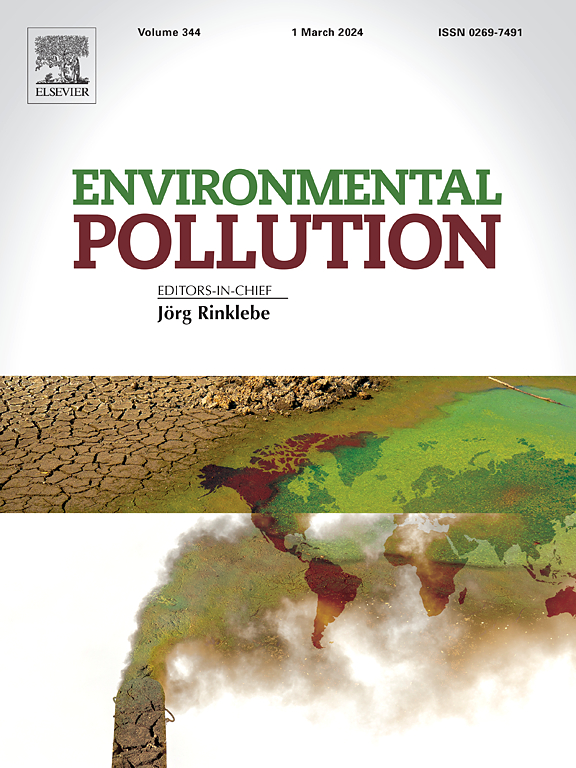波斯湾和阿曼海沿海边界地带微塑料的特征、行为和通量
IF 7.3
2区 环境科学与生态学
Q1 ENVIRONMENTAL SCIENCES
引用次数: 0
摘要
人们对沿海地区大气中的微塑料(MPs),包括它们与海面的相互作用知之甚少。在这项研究中,采用多种取样技术(包括过滤水和抽吸空气以及部署垂直沉积物捕集 器阵列),对波斯湾和阿曼海的低层大气、平流空气、沉积尘埃、沿海沉积物和海水中的微塑 料进行了测定和定性。在所有样本中都检测到了 MPs,主要是纤维,在大多数情况下,这些纤维都很小(100 微米),呈黑色。在平流空气中捕获的多孔纤维数量没有随高度变化的趋势,在陆地和海洋上的不同地点或部署之间也没有差异,但在强风时会明显增加。大气悬浮物以及沉积尘埃、沉积物和海水中的 MPs 分布也不均匀。根据形态和颗粒大小(纤维百分比和小纤维百分比)以及聚合物密度,环境或运输途径的分馏非常明显。就后者而言,密度相对较低的聚合物(如聚乙烯、聚丙烯)在大气、平流空气和海水中含量较高,而密度较高的聚合物(如再生纤维素、聚对苯二甲酸乙二酯)在沉降尘埃和沉积物中含量较高。根据颗粒计数和 MP m-2 h-1 换算的通量显示,在陆地上,平流(高达 ∼ 1.2 x 106)比沉积(高达 ∼ 400)大至少三个数量级,但在海洋上,平流只比沉积大大约 400 倍。在不考虑任何再悬浮差异的情况下,这表明在海洋上空气传播的 MPs 净损失更大。根据沉积通量和空气中的浓度推算,低层大气中 MPs 的净沉降速度约为 1.2 至 13.1 米/小时,停留时间为 45 分钟至 8.3 小时。本文章由计算机程序翻译,如有差异,请以英文原文为准。


Characteristics, behaviour and fluxes of microplastics in the coastal boundary zones of the Persian Gulf and Oman Sea
Relatively little is known about microplastics (MPs) in the atmosphere of the coastal zone, including their interaction with the sea surface. In this study, MPs have been determined and characterised in the lower atmosphere, advecting air, depositing dusts, coastal sediments and seawater of the Persian Gulf and Oman Sea using a variety of sampling techniques (including filtration of water and pumped air and deployment of a vertical array of sediment traps). MPs were detected in all samples and were dominated by fibres that were, in most cases, small (<100 μm) and black. MP numbers captured in advecting air showed no trends with height or differences between locations or deployments over land and sea, but a clear increase was observed during strong winds. MPs in atmospheric suspension and in deposited dusts, sediments and seawater were also heterogeneously distributed. Environmental or transport pathway fractionation was evident according to morphology and particle size (% fibres and % small fibres) and to polymer density. Regarding the latter, relatively low-density polymers (e.g., polyethylene, polypropylene) were more abundant in the atmosphere, advecting air and seawater, whereas higher density polymers (e.g., regenerated cellulosics, polyethylene terephthalate) were more abundant in settling dusts and sediments. Fluxes, based on particle counts and converted MP m−2 h−1, revealed advection (up to ∼ 1.2 × 106) was greater than deposition (up to ∼ 400) by at least three orders of magnitude over land but only by a factor of a few hundred over sea. Neglecting any differences in resuspension, this suggests a greater net loss of airborne MPs over the ocean. Net settling velocities for the population of MPs in the lower atmosphere, derived from depositional fluxes and concentrations in air, ranged from about 1.2 to 13.1 m h−1, with residence times at an elevation of 10 m ranging from 45 min to 8.3 h. Our observations suggest that long-range transport of the type of MPs detected is constrained by a succession of deposition-resuspension cycles that must be factored into future modelling.
求助全文
通过发布文献求助,成功后即可免费获取论文全文。
去求助
来源期刊

Environmental Pollution
环境科学-环境科学
CiteScore
16.00
自引率
6.70%
发文量
2082
审稿时长
2.9 months
期刊介绍:
Environmental Pollution is an international peer-reviewed journal that publishes high-quality research papers and review articles covering all aspects of environmental pollution and its impacts on ecosystems and human health.
Subject areas include, but are not limited to:
• Sources and occurrences of pollutants that are clearly defined and measured in environmental compartments, food and food-related items, and human bodies;
• Interlinks between contaminant exposure and biological, ecological, and human health effects, including those of climate change;
• Contaminants of emerging concerns (including but not limited to antibiotic resistant microorganisms or genes, microplastics/nanoplastics, electronic wastes, light, and noise) and/or their biological, ecological, or human health effects;
• Laboratory and field studies on the remediation/mitigation of environmental pollution via new techniques and with clear links to biological, ecological, or human health effects;
• Modeling of pollution processes, patterns, or trends that is of clear environmental and/or human health interest;
• New techniques that measure and examine environmental occurrences, transport, behavior, and effects of pollutants within the environment or the laboratory, provided that they can be clearly used to address problems within regional or global environmental compartments.
 求助内容:
求助内容: 应助结果提醒方式:
应助结果提醒方式:


